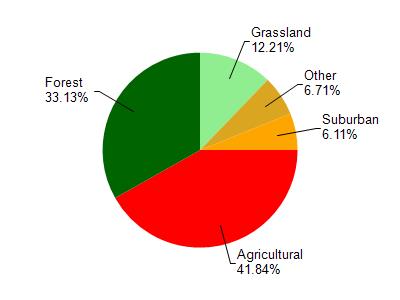Portage, Wood
No
No
No
Fish and Aquatic Life
Overview
This is a recreational drainage impoundment formed by a 23- foot head dam owned by Wood County, located on Buena Vista (Fourmile) Creek. The water is medium brown colored, hard, alkaline which has a low transparency. Northern pike, white bass, largemouth bass, rock bass, perch, crappies, bluegills, pumpkinseed, bullheads, redhorse, white suckers, and carp are the fish species present. The lake is part of the South Wood County Park complex. Public multiple-use facilities are available. Commercial resort facilities are present and there are 53 dwellings. Silting-in of the upper end of the impoundment, aquatic vegetation, and stunted panfish have been problems. The duck population is reportedly very low although there is some nesting by wood, mallard and teal.
Source: 1967, Surface Water Resources of Wood County Wazeecha Lake, T22N, R6E, S25 Surface Acres = 148, S.D.F. = 2.35, Maximum Depth = 23 ft
Date 1967
Author Aquatic Biologist
General Condition
Wazeecha Lake (1391200) was assessed during the 2016 listing cycle; total phosphorus and chlorophyll sample data were clearly below 2016 WisCALM listing thresholds for the Recreation use and Fish and Aquatic Life use. This water is meeting these designated uses and is not considered impaired.
Date 2015
Author Ashley Beranek
Condition
Wisconsin has over 84,000 miles of streams, 15,000 lakes and milllions of acres of wetlands. Assessing the condition of this vast amount of water is challenging. The state's water monitoring program uses a media-based, cross-program approach to analyze water condition. An updated monitoring strategy (2015-2020) is now available. Compliance with Clean Water Act fishable, swimmable standards are located in the Executive Summary of Water Condition in 2018. See also the 'monitoring and projects' tab.
Reports
Management Goals
Wisconsin's Water Quality Standards provide qualitative and quantitative goals for waters that are protective of Fishable, Swimmable conditions [Learn more]. Waters that do not meet water quality standards are considered impaired and restoration actions are planned and carried out until the water is once again fishable and swimmable
Management goals can include creation or implementation of a Total Maximum Daily Load analysis, a Nine Key Element Plan, or other restoration work, education and outreach and more. If specific recommendations exist for this water, they will be displayed below online.
Monitoring
Monitoring the condition of a river, stream, or lake includes gathering physical, chemical, biological, and habitat data. Comprehensive studies often gather all these parameters in great detail, while lighter assessment events will involve sampling physical, chemical and biological data such as macroinvertebrates. Aquatic macroinvertebrates and fish communities integrate watershed or catchment condition, providing great insight into overall ecosystem health. Chemical and habitat parameters tell researchers more about human induced problems including contaminated runoff, point source dischargers, or habitat issues that foster or limit the potential of aquatic communities to thrive in a given area. Wisconsin's Water Monitoring Strategy was recenty updated.
Grants and Management Projects
Monitoring Projects
| WBIC | Official Waterbody Name | Station ID | Station Name | Earliest Fieldwork Date | Latest Fieldwork Date | View Station | View Data |
|---|
| 1391200 | Wazeecha Lake | 10059975 | Wazeecha Lake at Bay View | 8/9/2025 | 8/9/2025 | Map | Data |
| 1391200 | Wazeecha Lake | 10059968 | Wazeecha Lake at Wazeecha Walking Path Bridge | 8/9/2025 | 8/9/2025 | Map | Data |
| 1391200 | Wazeecha Lake | 10040172 | Lake Wazeecha Wazeecha Ave White Beach | 8/9/2024 | 8/9/2024 | Map | Data |
| 1391200 | Wazeecha Lake | 723125 | Wazeecha Lake - Deep Hole | 7/31/1973 | 9/11/2025 | Map | Data |
| 1391200 | Wazeecha Lake | 10059977 | Wazeecha Lake at Buena Vista | 8/9/2025 | 8/9/2025 | Map | Data |
| 1391200 | Wazeecha Lake | 10040171 | Lake Wazeecha S Park Rd Red Beach | 8/9/2024 | 8/9/2024 | Map | Data |
| 1391200 | Wazeecha Lake | 10018241 | Lake Wazeecha -- Access | 5/10/2003 | 8/9/2025 | Map | Data |
| 1391200 | Wazeecha Lake | 10007536 | Wazeecha Lake | 6/1/1997 | 8/7/2025 | Map | Data |
| 1391200 | Wazeecha Lake | 10059976 | Wazeecha Lake at Shady Rest | 8/9/2025 | 8/9/2025 | Map | Data |
|

Watershed Characteristics
Wazeecha Lake is located in the Fourmile and Fivemile Creek watershed which is 213.96 mi². Land use in the watershed is primarily agricultural (41.80%), forest (33.10%) and a mix of grassland (12.20%) and other uses (12.80%). This watershed has stream miles, lake acres and 13,528.97 wetland acres.
Nonpoint Source Characteristics
This watershed is ranked Medium for runoff impacts on streams, Medium for runoff impacts on lakes and High for runoff impacts on groundwater and therefore has an overall rank of High. This value can be used in ranking the watershed or individual waterbodies for grant funding under state and county programs.However, all waters are affected by diffuse pollutant sources regardless of initial water quality. Applications for specific runoff projects under state or county grant programs may be pursued. For more information, go to surface water program grants.